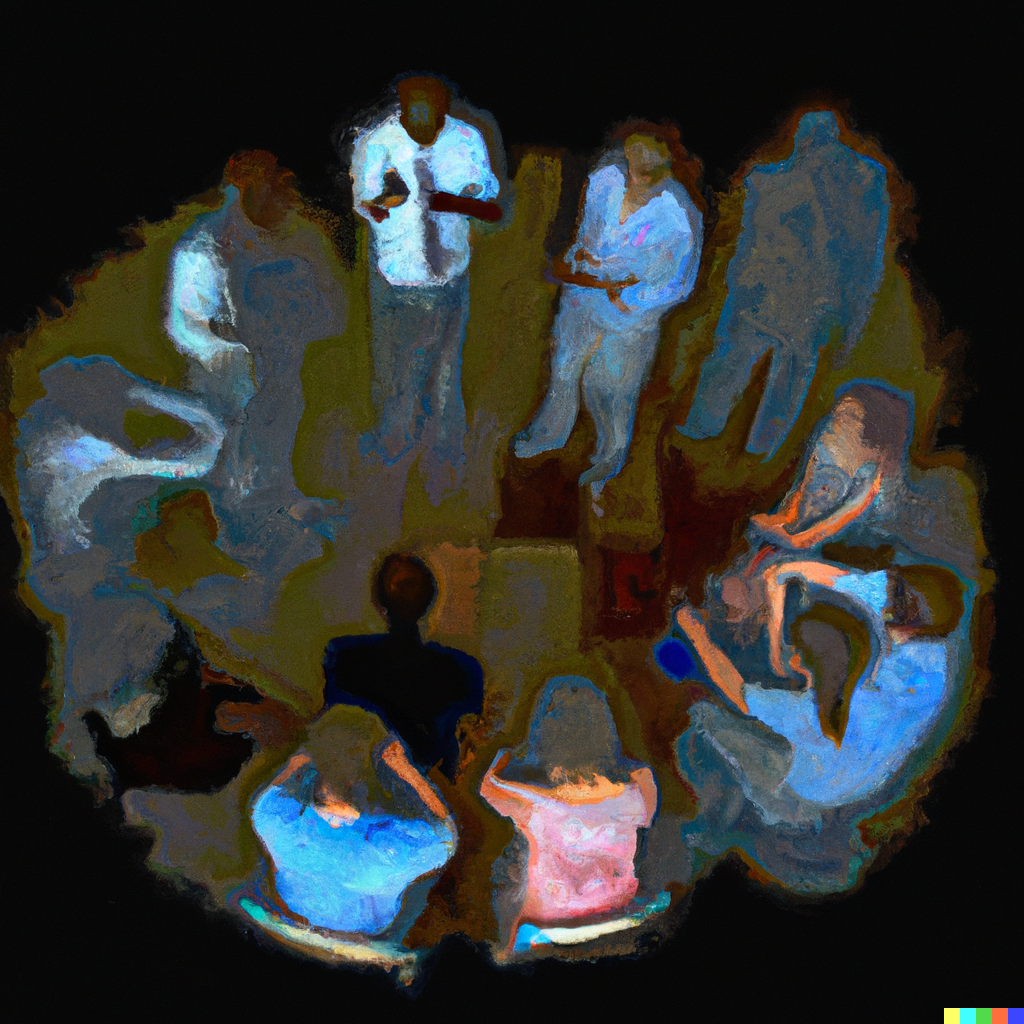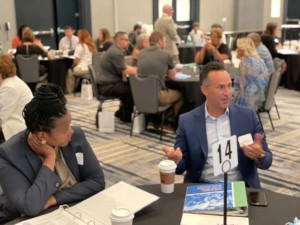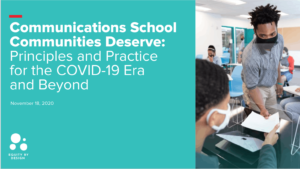Purpose and Process to Ignite Intentional Conversations
Key Points
-
Intentional relationships fuel intentional conversations; intentional conversations bolster intentional relationships.
-
If the facilitator already has “an answer” in mind, the discussion will suffer.

By: Darcy Bakkegard
You ask a question. You commit to wait time. You scan the room. A pin drops. You hear it. A few twitches and the general lack of eye contact tell you this isn’t going anywhere.
If you’re battling discussion apathy, ignite authentic conversations with two ingredients: A clear process and a specific purpose.
Utilize a Process
The ideal discussion group, according to researchers at Oxford and Arizona State Universities, is four people. Four. While multiple conversations may feel disjointed or harder to track, establishing a discussion process ensures you can maintain accountability while increasing participation and diversity of thought. No-tech, low-tech, and tech-fueled options abound, ensuring you have fresh but safely familiar approaches for any topic. Best of all, when you prime the pump with strategic small-group discussions, you can dedicate whole-group discussions to higher-level synthesis.
Curated Conversations
Christy Torres and Erin Holland of Onslow County Schools modeled at ISTE 2023 how they use Wakelet to curate meaningful class discussions. The team had two goals: change a preexisting reading comprehension task from the basic “answering questions on a worksheet” to something more engaging and authentic; and incorporate and increase student discourse.
Working in small groups, students discuss a set of 6-8 questions, recording their responses on paper. They then post their BEST 4-5 answers on the class Wakelet (Padlet, Jamboard, Slides- choose your favorite curation tool). The Wakelet is set up in columns, with one question per column and students post answers in the corresponding column. The class then compares all the answers, stimulating a whole class discussion -at times a debate- of what makes an answer particularly effective. Finally, groups review their answers, comparing those they did NOT post to the answers that were posted. At every level, all students are engaged: creating the answers, deciding which of their responses are particularly “good;” and analyzing how their responses compare to others.
Holland shared that the curated conversations addressed both of their goals and “enabled us to extend the student discourse beyond the table groups to include everyone in the class. Rather than completing a worksheet where there is no conversation or a traditional call-and-response activity where the same few students always answer aloud, the discussions at the tables and column response format helped ensure all students had the opportunity to participate in the discussion.”
Furthermore, Torres noted two additional benefits of the method: students “were more likely to reference the text, especially if there was a difference of opinion” and since groups were working together, the teacher was able to “listen to the discussions around the room and address any misunderstandings or point the groups back to particular areas of the rest to reread.”
Similarly, a Conversation Menu can help teachers/facilitators organize and build conversation concepts. Prime the pump with a tempting appetizer, provide groups with rich main dish choices, then wrap up with savory and sweet dessert options.
Poster Rotation Group Discussions
Like curated conversations, poster discussions allow small groups to collaborate while still seeing and learning from the thinking happening in other groups. Divide “posters” into small tasks focusing on the content you want students to discuss or skills you want them to cultivate. Students work together and dig in while you rotate to support, nudge, and assist. For six groups, have six posters with five tasks per poster; that way, each group ends up with their original poster. Students work as a team to answer/complete the first task. Rotate posters. Groups discuss what the previous group wrote, then complete task two. Rotate and continue until each group has seen every poster and groups have their original poster back. (Note: You could have smaller groups and make two sets of each poster.) The groups then synthesized what everyone else wrote.
The hands-on nature of creating the poster stimulates discussion and forces students to be succinct in their responses. The focused tasks require groups to utilize key resources while reviewing what others have added to the posters. Like the curated conversations, the poster process frees the teacher to circulate, guiding groups when needed and pushing for deeper connections.
Once complete -especially if used for more than one class period- posters can be displayed and used for an additional gallery walk discussion. Give students post-its or paper and guide them to compare a set of posters on the same topic: What do all the posters have in common? What did one or two posters emphasize that was unique? Use the post-its to facilitate a small or whole group discussion.
World Cafe
This interactive discussion format blends solo reflection with small group discussion over three rounds, building to group synthesis. While you can use this to discuss any topic, it’s particularly effective to brainstorm solutions to challenges.
First, identify what you want to solve, figure out, or otherwise make better. Devise three questions to guide the discussion. The first question is often framed in a negative way. It should allow people to discuss the barriers that cause the challenge to persist. It may sound like a ‘venting’ session in action, but this is an important first step. It allows people to see patterns and identify which challenges are the most persistent. The second question should be framed in a positive, forward-thinking manner. This question should allow participants to brainstorm their vision for the future. In an ideal world, what would they want to see happen? Finally, question three should allow participants to get proactive. It should enable people to brainstorm how they can overcome their challenges so that they can best get to their ideal solution.
There will be three rounds, one question per round. Everyone will answer the same question. Each round has a 1-minute solo brainstorm during which each person writes down as many responses to the question as they can. Groups then have 8-10 minutes to do group brainstorming, sharing, and organizing their solo reflections. One person acts as the ‘secretary,’ writing down all ideas on the flip chart paper. When time is up, all but the secretary switches groups. The secretary for each group summarizes that team’s ideas for the new table mates. Repeat the process for questions 2 and 3.
From all of this data, you can now harvest the ideas. As a whole group or in smaller teams, identify the key challenges (question 1), the strengths to draw on (question 2), and possible solutions (question 3). This is a great way to launch PBLs, tackle challenges, and empower students to design their own solutions.
Central to all of these methods: the teacher/facilitator gets out of the way and allows students/participants to talk. While the teacher circulates and supports, they must act as a trusted, neutral facilitator. It has to be safe for people to share without judgment or worry about right/wrong answers. So put on a poker face, play referee when necessary, and get out of the way.
Define the Purpose
No matter who is in the room, the discussion will falter without a clear goal, a goal that must be more authentic than just a mark in a grade book or a completion of staff hours. Are you on a quest to unlock knowledge? To synthesize data? Are you problem-finding or goal-setting? Is the task at hand about developing conversation and collaboration skills? Clearly identifying the purpose will help build trust and -hopefully- generate more participation.
Start with Good Questions
Short answers, right/wrong, and yes/no questions won’t stimulate anything. If the facilitator already has “an answer” in mind, the discussion will die. To get started, tap into the abundance of question-writing resources available. RightQuestions.org and its Question Formulation Technique provide practical, proven strategies to help cultivate thinkers and build a climate of inquiry. As you implement the strategies outlined above, you will start to see what types of questions work for your learners/audience.
Make it Authentic
Does it matter to students? The strategies outlined above will certainly spark conversations around any classroom content, but the desire to foster intentional conversations should also be part of a greater shift away from set content to skills-based learning. Allow students to discuss topics that impact them: the future of work, prosperity for all, the environment and being solutionaries, global citizenship. In every classroom, in every subject, we have opportunities to make learning magical by connecting it to the actual needs of students. When students see that we are actively listening to their ideas, their concerns, their needs, they will engage in intentional conversations.
Conclusion
If these strategies aren’t working for you, you have a classroom culture issue. The thing about intentional conversations: they are predicated on intentional relationships. Intentional relationships fuel intentional conversations; intentional conversations bolster intentional relationships. The two are interdependent. As classroom and school leaders, you cannot hope to have truly meaningful conversations on subjects of import without relationships -teacher to student; student to student- grounded in trust, honesty, forgiveness, lack of judgment, and transparency.
Darcy Bakkegard is a change consultant, co-founder of The Educators’ Lab, and co-author of The Startup Teacher Playbook. After more than a decade in the classroom teaching English and theatre, Darcy now creates the type of PD she always wanted, driving change in education and empowering teachers as changemakers. Through her work, teachers reconnect with their purpose, rekindle their spark for teaching, and reignite the JOY of teaching and learning.







0 Comments
Leave a Comment
Your email address will not be published. All fields are required.